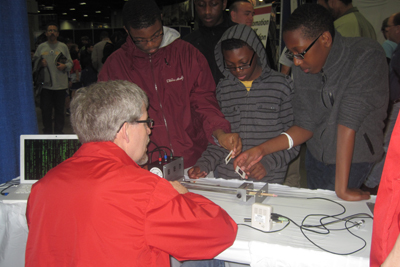Cornell makes physics fun at D.C. science expo

Communicating with light and building a photon factory were among activities led by Cornell scientists, staff and students meant to engage and inspire the public at the second USA Science and Engineering Festival in Washington, D.C., April 28-29.
The nation's largest celebration of science and engineering in the United States, this year's festival was sponsored by Lockheed Martin and featured more than 3,000 interactive exhibits and 100 stage shows hosted by some of the biggest celebrities in the science world. For the second time, staff members from the Cornell Laboratory for Accelerator-Based Sciences and Education (CLASSE) and the Center for Nanoscale Systems (CNS) set up science activities for public viewing at the D.C. Convention Center expo. The Office of the Vice Provost for Research sponsored Cornell's participation in the festival.
Lora Hine and Erik Herman of CLASSE, with help from Cornell alumnus Trevor French, helped 1,800 participants create multi-colored wearable LED (light emitting diode) circuits from parts available at Cornell's booth. Affectionately called "blinkys," they were adorned with a Cornell seal sticker as the finishing touch. The booth was packed with on-lookers and blinky assemblers during the two-day exposition.
In the other Cornell activity, Julie Nucci from CNS, Jim Overhiser, lead instructor for the Cornell Institute for Physics Teachers, and Cornell graduate Jonathan Smythe demonstrated sound waves traveling through light. Illustrating the basics of fiber optic communication, three different songs, each in its own band of light, were shined through a single light-pipe to a receiver and amplifier. There were looks of incredulity and disbelief as each song, isolated from the others by color filters, came through loud and clear.
Cornell's outreach mission aligns with the goals embraced by the USA Science and Engineering Festival, inviting continued support and yearly sponsorship by the provost's office. Stimulating the interest of our nation's youth in science, technology, engineering and mathematics (STEM) fields, appealing to diverse audiences of all ages and backgrounds, and engaging some of the greatest minds in science are the cornerstone of successful community education and engagement. Based on the thousands of blinkys illuminating the Washington, D.C., area, a newly ignited curiosity in the science of light has been attained.
Media Contact
Get Cornell news delivered right to your inbox.
Subscribe